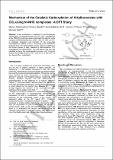Files in this item
Mechanism of the catalytic carboxylation of alkylboronates with CO2 using Ni-NHC complexes : a DFT study
Item metadata
| dc.contributor.author | Delarmelina, Maicon | |
| dc.contributor.author | Marelli, Enrico | |
| dc.contributor.author | Carneiro, Jose | |
| dc.contributor.author | Nolan, Steven | |
| dc.contributor.author | Buehl, Michael | |
| dc.date.accessioned | 2018-09-28T23:44:38Z | |
| dc.date.available | 2018-09-28T23:44:38Z | |
| dc.date.issued | 2017-10-20 | |
| dc.identifier | 250972928 | |
| dc.identifier | 4a700210-b998-4f99-8ea0-c26e080a37fe | |
| dc.identifier | 85032854144 | |
| dc.identifier | 000413337400034 | |
| dc.identifier.citation | Delarmelina , M , Marelli , E , Carneiro , J , Nolan , S & Buehl , M 2017 , ' Mechanism of the catalytic carboxylation of alkylboronates with CO 2 using Ni-NHC complexes : a DFT study ' , Chemistry - A European Journal , vol. 23 , no. 59 , pp. 14954-14961 . https://doi.org/10.1002/chem.201703567 | en |
| dc.identifier.issn | 0947-6539 | |
| dc.identifier.other | ORCID: /0000-0002-1095-7143/work/48131802 | |
| dc.identifier.uri | https://hdl.handle.net/10023/16107 | |
| dc.description | The authors acknowledge FAPERJ for providing research grants and financial support. MB thanks the School of Chemistry and EaStCHEM for support and for access to a computer cluster maintained by Dr H. Früchtl. JWMC acknowledges CNPq for a research grant. The experimental work was supported via our membership of the UK Catalysis Hub consortium funded by EPSRC (grants EP/K014706/2, EP/K014668/1, EP/K014854/1 and EP/K014714/1). SPN gratefully acknowledges the European Commission for support in the form of an ERC Advanced Researcher grant (227817-FUNCAT). | en |
| dc.description.abstract | A new mechanism is proposed for the Ni-catalysed carboxylation of organoboronates with CO2. DFT investigations at the PBE0-D3 level have shown that direct CO2 addition to the catalysts [Ni(NHC)(Allyl)Cl] (1NHC, NHC = IMe, IPr, SIPr and IPr*) is kinetically disfavored and formation of the Aresta-type intermediate is unlikely to occur. According to the mechanism proposed here, the carboxylation process starts with addition of the borate species to 1NHC, followed by transmetalation, CO2 cycloaddition and carboxylation. The rate-determining step was identified as being the transmetalation process, with computed relative free energy barriers of 34.8, 36.8 and 33.5 kcal mol-1 for 1IPr, 1SIPr and 1IPr*, respectively | |
| dc.format.extent | 2252263 | |
| dc.language.iso | eng | |
| dc.relation.ispartof | Chemistry - A European Journal | en |
| dc.subject | Carbene ligands | en |
| dc.subject | Nickel | en |
| dc.subject | N-Heterocyclic carbene | en |
| dc.subject | Carbon dioxide | en |
| dc.subject | Carboxylation | en |
| dc.subject | DFT | en |
| dc.subject | QD Chemistry | en |
| dc.subject | DAS | en |
| dc.subject.lcc | QD | en |
| dc.title | Mechanism of the catalytic carboxylation of alkylboronates with CO2 using Ni-NHC complexes : a DFT study | en |
| dc.type | Journal article | en |
| dc.contributor.sponsor | EPSRC | en |
| dc.contributor.sponsor | European Research Council | en |
| dc.contributor.institution | University of St Andrews. School of Chemistry | en |
| dc.contributor.institution | University of St Andrews. EaSTCHEM | en |
| dc.identifier.doi | 10.1002/chem.201703567 | |
| dc.description.status | Peer reviewed | en |
| dc.date.embargoedUntil | 2018-09-29 | |
| dc.identifier.grantnumber | EP/K014854/1 | en |
| dc.identifier.grantnumber | FP7-227817 FUNCAT | en |
This item appears in the following Collection(s)
Items in the St Andrews Research Repository are protected by copyright, with all rights reserved, unless otherwise indicated.

